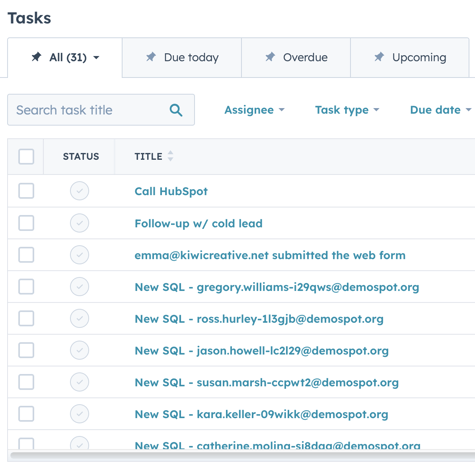Account-based marketing (ABM) is a strategic approach that allows businesses to focus their marketing efforts on specific target accounts. Unlike traditional marketing strategies that cast a wide net in the hopes of capturing leads, ABM takes a more personalized approach by directly targeting key accounts that are most likely to convert into customers—essentially treating them as markets in their own right. By curating marketing initiatives specific to the needs and interests of these target accounts, businesses can increase their chances of success by focusing on quality rather than quantity.
Many companies feel stuck with the level of research and personalization required to get started with ABM, but it doesn’t have to be this way…give HubSpot’s native Target Account feature a try!
How can HubSpot help with account-based marketing?
Like we said above, start by utilizing HubSpot’s target accounts feature! This feature allows you to have an easily accessible command center to monitor account progress, add new target accounts, and make updates. Available with both Marketing Hub and Sales Hub Professional and Enterprise levels, the Target Accounts page makes it easy to filter through and identify next steps to keep the ball rolling.
Here's how it works:
In the Marketing Hub, businesses can create targeted marketing content specifically tailored to their target accounts. This includes personalized emails, landing pages, and ads that resonate with the unique challenges and pain points of each target account.
HubSpot enables sales teams to effectively engage with target accounts in the Sales Hub. Using features such as email tracking, meeting scheduling, and activity logging, sales reps can build meaningful relationships and close deals more efficiently.
Some of the key benefits of using HubSpot for account-based marketing include:
- Improved Alignment: When it comes to account-based marketing, alignment between marketing and sales teams is crucial. HubSpot provides a centralized platform that is visible by both teams and enables them to collaborate effectively. Marketing teams can easily share valuable insights and data with sales teams, allowing them to better understand the needs and preferences of target accounts. This alignment ensures that marketing efforts are tailored to the specific requirements of each account, increasing the chances of success.
- Personalization: Personalization is a key element of successful account-based marketing. With Target Accounts, it's easy to create personalized emails, targeted CTAs, and dynamic landing pages, allowing marketers to tailor their messaging to the unique needs and preferences of each account. By delivering relevant and personalized content, businesses can establish stronger connections with their target accounts, increasing engagement and driving conversion rates.
- Automation: Automation simplifies the ABM process, allowing businesses to scale their efforts and maximize efficiency. Account-based marketing often involves managing a large number of target accounts simultaneously. But workflows allow admins to automate lead assignment and task creation, form submission confirmation, and lead nurturing campaigns. By automating repetitive and time-consuming tasks, both sales and marketing teams can focus their efforts on high-value activities, such as building relationships with key decision-makers and crafting compelling content. Automation not only saves time but also ensures that each account receives the attention it deserves.

- Analytics: HubSpot provides comprehensive out-of-the-box reporting to track the success of ABM campaigns. Measuring the success of account-based marketing campaigns is essential for optimizing future efforts. Marketers can track key metrics such as engagement rates, conversion rates, and revenue generated from target accounts, while sales leaders can monitor deal conversion rates and the number of touches required to close a deal. These insights allow businesses to identify what works and what doesn't, enabling them to refine their strategies and make data-driven decisions that drive better results.

Identifying and prioritizing target accounts
The first step in implementing ABM using HubSpot’s Target Accounts is identifying and prioritizing target accounts. HubSpot offers a variety of tools and features to help businesses in this process including:
- Ideal Customer Profile (ICP) and Buyer Personas: HubSpot allows businesses to define their ideal customer profile or buyer personas, which serves as a blueprint for identifying target accounts.

- HubSpot Score: With HubSpot's default Score property, users can award points based on predetermined firmographic and behavioral criteria, and automate the process of flagging sales-ready accounts.

By leveraging these tools, businesses can identify high-potential target accounts and prioritize their efforts accordingly, increasing their chances of success.
Automating ABM with HubSpot target accounts
Automation is a key component of successful ABM, and Target Accounts makes it easy to automate various aspects of the process with features like:
- Triggered Workflows: Enroll accounts into workflows based on specific actions or behaviors, such as a form submission or email reply. This ensures timely and relevant communication throughout the buyer's journey.

- Personalization Tokens: Dynamically insert account-specific information into their marketing materials, like Company Name and Industry, further enhancing the level of personalization and relevance.

- Smart Content in Emails: Present a different subject line, section of copy, image, or button in your emails based on Lifecycle Stage or list membership (psst…we have a HubSpot Helper Video for that.)

- Smart Content in Blog Posts & Landing Pages: Show Target Accounts different content based on a wide variety of criteria, including country, preferred language, and ad source.

Understanding Target Account Metrics in HubSpot
Metrics play a crucial role in measuring the success of ABM campaigns, and HubSpot provides a range of Target Account reports to track performance including:
- Engagement: HubSpot's engagement metrics reveal how actively target accounts are interacting with marketing materials and sales outreach.
- Conversion Rates: Tracking conversion rates allows businesses to understand how effective their ABM efforts are in driving target accounts to take desired actions.
- Opportunity Value: By assigning a value to each target account based on their potential revenue, businesses can prioritize their efforts and estimate the impact of their ABM campaigns.

Conclusion
With ABM, marketing outreach is highly focused and tailored specifically to the needs and interests of each target account, increasing effectiveness, decreasing manpower and time-spent, and overall conversion rates.
By leveraging Target Accounts, businesses can deliver personalized content that addresses specific pain points, engage target accounts at every stage of their buyer's journey, and streamline the qualification and outreach process, resulting in more meaningful interactions and ultimately, higher conversion rates.
Ready to get started? See how to set-up target accounts here!







